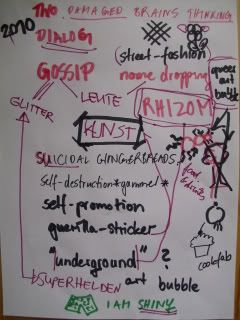My second thought on Biennale curator Artur Żmijewski's call to please send in art and a statement of „... your political inclination (e.g. rightist, leftist, liberal, nationalist, anarchist, feminist, masculinist ...) ...“ was a sudden reminiscence of earlier Facebook days, when you could still state your political views by ticking the box, labelling yourself on a scale of very liberal to very conservative. The middle-ground being moderate, which to me always sounded very much like the apathetic option, or Żmijewski's alternative to giving that statement, namely being „... not interested in politics at all“. At least Facebook had the other option, too. Today, you can scribble in whatever you please, and explain – as far as the word limit may allow you – just what kind of an apathetic liberal you are, of the American or German breed - - -
To sum up, the Open Call left me thinking something along the lines of Is that a trick question? And, Let's hope it's a trick question!
As Żmijewski goes on to elaborate in his curator's statement, he deems such a process of self-labelling necessary however, because there seems to the an „invisible rule“ within contemporary art by which artists are kindly asked to produce „'political'“ art, however, from an „unindentified political position“, which – as he states, justly – simply doesn't exist. I have never heard of such a rule, nor did I ever expect an artist to live by it (neither from an art critic's, nor a spectator's standpoint) – on the contrary. But then again I am not an artist in any professional, bread-and-butter sense; I never had to answer to a gallery owner or a curator, I don't even have to answer to my editor, yet – only to the voices in my head - -
Me: „What's with all the pretentious self-indulgence?“
Me: „Hm?“
Żmijewski's goal, as he points out, is to get the artists to break that very rule and lay bare „the invisible/ hidden structure“, the „obscene background of [their] art“, their politics. And, he wants them to remember that, after all, „[p]olitics are not, as politicians would like to convince us, fights for power or dirty games. They are the language of our collective needs which people share.“ The cynic in me (or is it the realist?) wants to shriek: Aren't we beyond irony?
Żmijewski: „...the curatorial choice will [not] be based on preferred political identity [as stated by the artist] [...] [but] on intuition and ambiguity. But this time intuition and ambiguity will be a little deformed by this over-obvious political element. So, we will see what happens.“
The Cynic again: Don't we know what will happen? I read it in the newspaper on Thursday: Post-Tucson: Sarah Palin refrains from calling Obama Hitler until Monday morning. Aren't we already living in the aftermath of the deformation of „intuition and ambiguity“, read reality, by the „over-obvious political element“, read ideology, in which the vocabulary of the „language of our collective needs“ has shrunken to nothing but statements of political inclinations, even been replaced by them? It is a game of politicians calling each other names, and as Żmijewski suggests, the artist should join in, starting with himself. To make that work, i.e. to give that „little deformation“ an outcome that cuts through it all and is mind-mangling (and I want nothing less), Żmijewski will have to sign up for a serious case of short-leash / tight-rope / whiplash curating – nothing else but strangling the artists/labels/artworks until they suffocate or snap. Oh, the possibilities!
But step aside, you Cynic, and come in, Idealist, for Żmijewski is pointing to Hannah Arendt as the reference point for his call to „describe what we do as artists also in pure (sic!) political terms“. To quote Arendt: The event illuminates its own past, but cannot be deduced from it. There is no such thing as causality, only contingency. Hence, the event, the Biennale itself, the performance of all that art hanging on all those walls in 2012 will render all good intentions and inclinations, as stated, labelled or mumbled („Hm? Other?“), futile anyway. Oh, the possibilities!
- - -
THAT'S HOW WEIRD IT'S GONNA BE (IV/last installment), 2011
exhibition flyer

THAT'S HOW WEIRD IT WAS (III), 2011
still from THROUGH THE BENT BACKED TULIPS / tiananmen square 2010 06 22 (2010)

THAT'S HOW WEIRD IT WAS (II), 2010
still from THE AGE OF THE UNDERSTATEMENT (song by The Last Shadow Puppets, video by Romain Gavras, 2008)

THAT'S HOW WEIRD IT WAS (I), 2010

